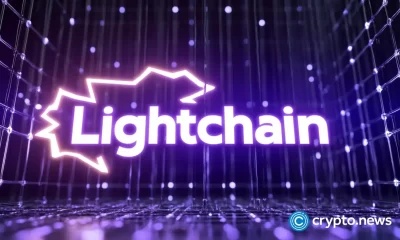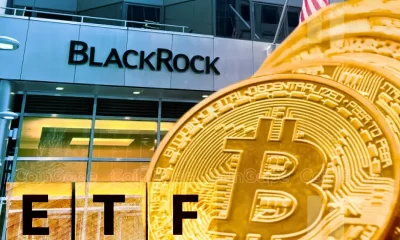Coins
Omni-Chain Approach Vital to Ethereum’s Future: Orbiter Co-Founder
Published
4 months agoon
By
admin

The development of omni-chain infrastructure could significantly impact the Ethereum ecosystem, potentially altering the dynamics of competition among rollups and reshaping the future of decentralized finance, according to Iris Cheung, co-founder of Orbiter Finance.
In an interview with Decrypt, Cheung highlighted the challenges faced by Ethereum’s current rollup-centric scaling approach in creating a unified user experience, and said the variety of rollup types and protocols adds complexity for users. This makes it more difficult to understand than using a single layer-1 system.
“Consider rollups as highway lanes,” she said. “If the Arbitrum lane is congested, you cannot simply switch lanes; adding more rollups doesn’t significantly enhance Ethereum’s scaling.”
“To achieve a more scalable future, we need to build infrastructure that can process cross-rollup transactions in parallel and ensure cross-chain transaction atomicity with minimal or no interaction with layer 1,” she explained.
To address these issues, Orbiter Finance is developing an omni-chain infrastructure to provide effective rollup coordination. This infrastructure includes components such as an omni-chain wallet address system, a cross-rollup relayer, and a liquidity aggregation layer.
Earlier this week, Orbiter Finance announced that it generated over 20,000 ETH—or about $55 million—in annual revenue from its cross-chain bridging protocol, and that the Orbiter Bridge facilitated over 24 million transactions with a total volume exceeding $16 billion.
According to data from DeFi Llama, Orbiter Finance’s 24-hour volume stands at $13.34 million. Cheung said the omni-chain approach could change the dynamics of the current race for total value locked (TVL) among rollups.
“The TVL competition will diminish as Ethereum layer-2 solutions focus on competing based on the liquidity and services they can offer within a more interconnected environment,” she stated.
According to Cheung, this shift could lead to a more collaborative ecosystem where rollups that successfully integrate with omni-chain solutions gain a competitive edge by providing users with better access to liquidity and lower transaction costs.
As a result, users will favor those offering the best cross-chain experiences.
“After the completion of the omni-chain infrastructure, users are unlikely to feel that they are conducting cross-chain transactions,” Cheung explained. “This is because the smart contract they interact with is inherently omni-chain.”
The company is now working towards decentralizing its Maker system to grant access to third-party liquidity providers, aligning with the ethos of decentralization.
This move comes after an investment from OKX Ventures earlier this year, aimed at ensuring the decentralized growth of layer-2 solutions while building essential infrastructure for the ecosystem.
Daily Debrief Newsletter
Start every day with the top news stories right now, plus original features, a podcast, videos and more.
Source link
You may like


Why it’s a better investment than Solana or Ripple in 2024


Six Bitcoin (BTC) Mutual Funds to Launch in Israel Next Week: Report


What Happens If Paul Atkins Dismisses the XRP Lawsuit?


Malicious Google ad campaign redirects crypto users to fake Pudgy Penguins website


BlackRock Bitcoin ETF (IBIT) Records Largest-Ever Outflow of $188M


Solana (SOL) Gearing Up: Is a New Surge on the Horizon?
Coins
Perpetual DEX Hyperliquid to Launch Native Token Following Bullish October
Published
4 weeks agoon
November 29, 2024By
admin

Hyperliquid, a decentralized perpetuals exchange, is challenging the conventional wisdom that venture capital is essential for success in crypto. Instead, it claims it’s relying on its touted tech and community-first approach.
The DEX’s Hyper Foundation, which oversees development, announced Thursday its token generation event, slated for early Friday at 2:30 AM ET, alongside an airdrop.
Over the past year, Hyperliquid has expanded from an exchange into a “full financial system,” claiming its liquidity now “rivals” that of “top exchanges,” its foundation said Thursday on X, formerly Twitter.
In October, Hyperliquid surpassed Jupiter and SynFutures, clocking a record $1.39 billion in daily trading volume, DeFiLlama derivatives data shows.
“The HYPE genesis event marks a key milestone in the journey, unlocking core functionality at every level of the stack,” it said.
Based on data from Aevo, a derivatives tracking platform, Hyperliquid has a projected valuation of $3 billion. At that valuation, the planned 310 million HYPE tokens allocated for the 31% community airdrop would be worth nearly $1 billion, marking Hyperliquid’s “genesis event” as one of the largest in DeFi, the project claims.
Once launched, the HYPE token will integrate directly into Hyperliquid’s core operations, the project said. Decrypt has reached out to Hyperliquid to learn more.
Beyond traditional governance roles, the token will also provide functionality for staking and transaction fees while enabling direct USDC trading pairs on the platform’s spot market.
What’s different?
Hyperliquid runs on a blockchain designed specifically for high-speed trading and financial applications. The platform uses HyperBFT, a proof-of-stake system that can process transactions almost instantly while maintaining security through network consensus.
The project is currently ranked as the top decentralized exchange for derivatives, posting $1.6 billion in 24-hour volume, according to data from DeFiLllama. Its all-time volume sits at roughly $428 billion.
Hyperliquid said in a blog post on Thursday there would be “no allocations for private investors, centralized exchanges, or market makers,” an approach that departs from how other projects typically allocate during launch, which often includes significant portions reserved for early backers and project leaders.
“No investors. No paid market makers. No fees to any company. Community first,” Hyperliquid claims on its website.
Still, roughly 24% of the tokens will be allocated to current and future core contributors of the network, and a further 6% will go towards the “Hyper Foundation budget,” the exchange said.
Edited by Sebastian Sinclair
Daily Debrief Newsletter
Start every day with the top news stories right now, plus original features, a podcast, videos and more.
Source link
Coins
Seven Things to Tell Your Crypto-Curious Relatives at Thanksgiving
Published
4 weeks agoon
November 28, 2024By
admin

It’s turkey time, and you know what that means: mountains of food, lots of reclining, and endless conversations with family members who describe what you do in passing as “computers.”
Well, dear reader, fear not because this year won’t be like the last few Thanksgivings. Crypto isn’t in the depths of a bear market, and your cousin doesn’t think you’re a crook anymore.
Now crypto is ascending again—and everyone wants financial advice, just like Thanksgiving from three years ago.
Below is a compiled list of handy talking points for your crypto-curious relatives, covering the industry’s most significant, recent developments. Stick to the facts, avoid shilling meme coins to the elderly, and you’ll be cruising to pie in no time.
Bitcoin just hit an all-time high price—why?
Bitcoin came within a few hundred bucks of the vaunted $100,000 milestone last week, and while the price has retreated a bit recently, it returned above $97,000 earlier Wednesday.
What’s driving the demand that’s pushed Bitcoin’s price record in recent weeks? Institutional and retail investors have expressed optimism that there will soon be a more favorable regulatory climate for digital assets in the U.S.
That’s thanks to the victory of self-proclaimed crypto enthusiast Donald Trump, along with the election of the most pro-crypto Congress to date.
Meanwhile, institutional investors’ forays into spot Bitcoin ETFs have also given traders reason to be optimistic, pumping up the price of Bitcoin over the year. In short, Bitcoin is more “legit” than ever in the eyes of Wall Street and politicians.
ETFs have made crypto investing simpler and safer
Your folks may have heard that BlackRock and Fidelity—which may be managing their pensions—are now involved in Bitcoin. What are these two Wall Street giants doing with crypto? Well, you can explain: They swallowed the orange pill.
OK, so you probably don’t need to use Crypto Twitter jargon. Still, you can tell them that traditional finance bigwigs now offer exposure to the two largest digital assets, Bitcoin and Ethereum, via exchange-traded funds (ETFs).
Thanks to long-awaited SEC approvals this year, top fund managers who manage different ETFs now let ordinary investors buy shares that track the price of the two via brokerage accounts. Even your technophobic aunt can down the orange pill with a couple of taps on her phone.
Crypto could flourish further under Trump
On the campaign trail this year, Trump made lots of promises about lots of things, including crypto. And while it remains to be seen whether he will live up to many of those commitments, signals are already indicating that he may be holding up the crypto end of the bargain—which could be a massive development for the industry.
First things first: last week, the president-elect nominated Scott Bessent as his Treasury Secretary. Bessent, a billionaire hedge fund manager, has indicated he’d back Trump’s proposal to establish a Bitcoin federal reserve. The plan would see the U.S. buy billions of dollars’ worth of Bitcoin to diversify its reserves.
Think of it this way: If your uncle says Bitcoin has no real value, you might soon be able to tell him the U.S. government backs the asset.
Pair that with Trump’s plans to unwind the SEC’s aggressive crypto crackdown completely, plus his oath to get the Republican-controlled House and Senate to approve laws that would firmly legalize most crypto activity swiftly, and it’s no wonder crypto has exploded in recent weeks. Experts say the market still has much, much higher to climb in the coming months, too.
Elon Musk’s D.O.G.E. is a real thing
The world’s richest man, Elon Musk, now has a role in Trump’s government: The Tesla CEO will lead the Department of Governmental Efficiency (D.O.G.E.) with billionaire Vivek Ramaswamy to supposedly clear up the bureaucracy.
What’s that got to do with crypto, though? Well, the new department’s acronym matches the ticker of Dogecoin, the original and most meme coin. That’s probably not a coincidence.
Elon Musk has for years spoken—and tweeted—about how it’s his favorite coin. This earned him the “Dogefather” title on Twitter, now called X, after he acquired the platform. While we can’t be 100% sure of the naming origins, Trump is selling a DOGE-themed t-shirt featuring himself, Musk, and a Shiba Inu—the mascot of Dogecoin.
Anyone can create a coin—and millions are trading
Don’t want to decide between Bitcoin or Ethereum? If you’d instead launch your own token, you can now do it much more efficiently than ever.
One of the most significant innovations from the most recent crypto cycle has been the creation of token launchpads, or platforms that allow anyone to near-instantly create a token with a few clicks and for a few cents worth of crypto.
The most notable launchpad, Pump.fun, a Solana-based platform, has given rise to some of the most memorable tokens from this cycle. Nearly four million tokens have been created on Pump.fun this year, ranging from animal tokens that have provided early traders with significant riches to those launched by crypto-curious celebrities like musician Iggy Azalea.
It’s getting easier to handle crypto
Crypto’s adoption barriers keep getting knocked down. Consumers now have a wide breadth of mobile app options to buy, sell, and interact with a variety of platforms.
Plus, the rise in smart wallets, which drastically simplify the onboarding process, is making it easier to get those previously intimidated by the technical complexities of crypto to participate on-chain.
With the launch of Ethereum and Bitcoin ETFs, those looking to gain crypto exposure have more traditional financial options. That option didn’t exist in the U.S. last Thanksgiving.
Tread carefully: Scams are still abundant
Are you looking to dive head-first into crypto? Not so fast—you’ll first want to get your sea legs.
The crypto industry is rife with scams, and a seemingly innocuous link to an airdrop could lead you to a wallet drainer: Say goodbye to all your coins!
Even if you manage to keep your crypto out of scammers’ grips, there’s no guarantee you’ll be able to keep your holdings from going to zero. Not many people make money trading crypto, and much fewer are getting rich off of it. Up to 80% of day traders lose money over time, according to a report published in The Journal of Finance.
It’s still incredibly easy to lose your shirt in crypto, whether by clicking a malicious link or betting on highly volatile coins. For newcomers, you’re probably best suited to sticking to the most significant coins via apps like Coinbase, Robinhood, Cash App, or buying into ETFs.
Want to go deeper? Be very careful—you’ll be thankful in the long run.
Written by Sander Lutz, Elizabeth Napolitano, Mat Di Salvo, and Logan Hitchcock
Edited by Sebastian Sinclair
Daily Debrief Newsletter
Start every day with the top news stories right now, plus original features, a podcast, videos and more.
Source link
Coins
Chill Guy Meme Coin Pumps Another 50% as Creator Fights Back
Published
1 month agoon
November 25, 2024By
admin

From TikTok trends to crypto wallets, the “Chill Guy” meme has become an internet phenomenon, turning a laid-back cartoon dog into the face of a million-dollar market cap crypto.
Since its November 15 launch, the Chill Guy meme coin ($CHILLGUY) ballooned from a $10 million market cap to over $461 million, driven by the widespread popularity of the Chill Guy character—a relaxed anthropomorphic dog in a grey sweater, blue jeans, and red sneakers.
The Solana-based meme coin has increased in value by 50% over the last 24 hours alone, trading just shy of $0.50, per CoinGecko data. The token’s rise reflects the ongoing craze around meme coins, which continue to defy market norms with their volatile yet lucrative returns.
CHILLGUY features an anthropomorphic brown dog sporting a grey sweater, rolled-up jeans, and red sneakers, captivating audiences with its laid-back demeanor and has become a cultural phenomenon.
Frequently paired with humorous captions on platforms like TikTok, the character embodies a carefree attitude, resonating particularly with Gen Z audiences.
However, the coin’s ascent has not been without controversy. Behind the meme coin’s success lies growing tension as the meme’s creator, Philip Banks, pushes back against what he calls unauthorized exploitation of his work.
“Just putting it out there, Chill Guy has been copyrighted. Like, legally. I’ll be issuing takedowns on for-profit related things over the next few days,” Banks tweeted last week.
While Banks clarified that casual use by brands or individuals isn’t his target—“I just ask for credit. Or Xboxes.”—he noted unauthorized merchandise and shitcoins are crossing the line.
Despite these concerns, early adopters of CHILLGUY have seen massive returns, with one trader turning a $1,000 investment into over $1 million within days.
It isn’t the first time meme coins have demonstrated their ability to convert internet phenomena into financial windfalls.
Recently, the Peanut the Squirrel (PNUT) token—inspired by the viral story of Peanut, a pet squirrel euthanized by New York authorities—reached a $1 billion market cap within two weeks, while the First Convicted Raccoon (FRED) coin climbed 383% in a day.
Edited by Sebastian Sinclair
Daily Debrief Newsletter
Start every day with the top news stories right now, plus original features, a podcast, videos and more.
Source link

Why it’s a better investment than Solana or Ripple in 2024

Six Bitcoin (BTC) Mutual Funds to Launch in Israel Next Week: Report

What Happens If Paul Atkins Dismisses the XRP Lawsuit?

Malicious Google ad campaign redirects crypto users to fake Pudgy Penguins website

BlackRock Bitcoin ETF (IBIT) Records Largest-Ever Outflow of $188M

Solana (SOL) Gearing Up: Is a New Surge on the Horizon?

XRP, SOL, NEAR, DOGEN, and DOT poised to explode

Crypto Trader Turned $90 Into $3.25M As Token Skyrockets 5,500%

Here’s a Potential Downside Price Target for Cardano If ADA Sees New Correction, According to Benjamin Cowen

Which crypto will explode in 2025? Expert insights and predictions

XRP Price Pumps 7% On Christmas Eve, Will It Reach Yearly Highs?

XRP firmly above $1, ADA and LCAI to steal the spotlight

The 69 Dumbest Moments of the Year: 2024 Crypto Edition

Here’s What To Expect After Pectra Upgrade

Top 5 meme coins for 12,000x gains
182267361726451435

Why Did Trump Change His Mind on Bitcoin?

Top Crypto News Headlines of The Week

New U.S. president must bring clarity to crypto regulation, analyst says

Will XRP Price Defend $0.5 Support If SEC Decides to Appeal?

Bitcoin Open-Source Development Takes The Stage In Nashville

Ethereum, Solana touch key levels as Bitcoin spikes

Bitcoin 20% Surge In 3 Weeks Teases Record-Breaking Potential

Ethereum Crash A Buying Opportunity? This Whale Thinks So

Shiba Inu Price Slips 4% as 3500% Burn Rate Surge Fails to Halt Correction

Washington financial watchdog warns of scam involving fake crypto ‘professors’

‘Hamster Kombat’ Airdrop Delayed as Pre-Market Trading for Telegram Game Expands

Citigroup Executive Steps Down To Explore Crypto
Mostbet Güvenilir Mi – Casino Bonus 2024

NoOnes Bitcoin Philosophy: Everyone Eats
Trending

 3 months ago
3 months ago182267361726451435

 Donald Trump5 months ago
Donald Trump5 months agoWhy Did Trump Change His Mind on Bitcoin?

 24/7 Cryptocurrency News4 months ago
24/7 Cryptocurrency News4 months agoTop Crypto News Headlines of The Week

 News4 months ago
News4 months agoNew U.S. president must bring clarity to crypto regulation, analyst says

 Price analysis5 months ago
Price analysis5 months agoWill XRP Price Defend $0.5 Support If SEC Decides to Appeal?

 Opinion5 months ago
Opinion5 months agoBitcoin Open-Source Development Takes The Stage In Nashville

 Bitcoin5 months ago
Bitcoin5 months agoEthereum, Solana touch key levels as Bitcoin spikes

 Bitcoin5 months ago
Bitcoin5 months agoBitcoin 20% Surge In 3 Weeks Teases Record-Breaking Potential


